tow CADILLAC LYRIC 2023 Service Manual
[x] Cancel search | Manufacturer: CADILLAC, Model Year: 2023, Model line: LYRIC, Model: CADILLAC LYRIC 2023Pages: 424, PDF Size: 4.76 MB
Page 280 of 424
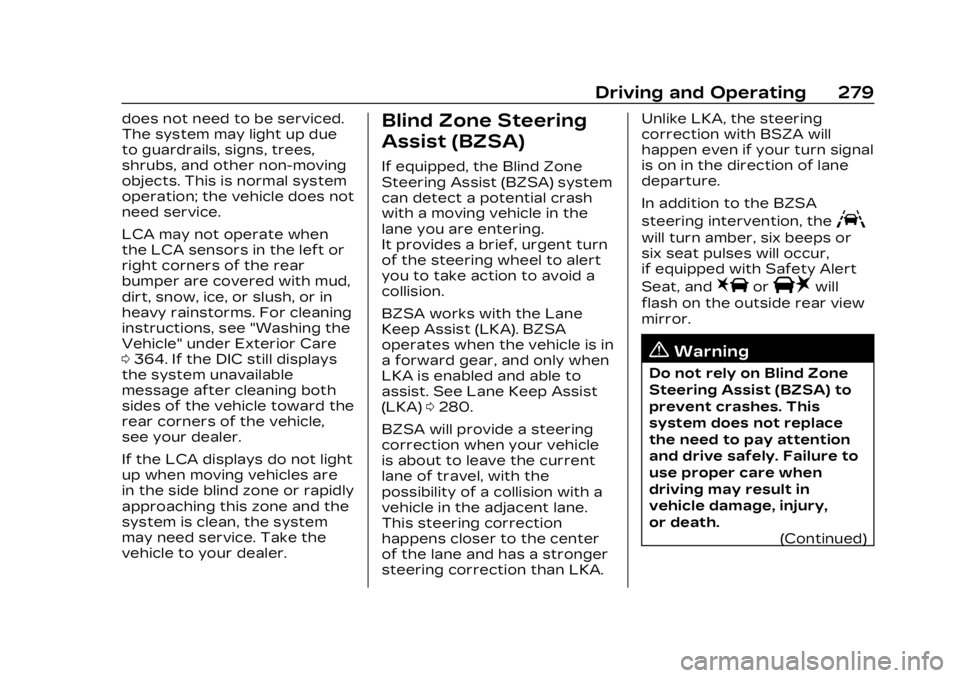
Cadillac Lyriq Owner Manual (GMNA-Localizing-U.S./Canada-15644413) -
2023 - CRC - 2/23/22
Driving and Operating 279
does not need to be serviced.
The system may light up due
to guardrails, signs, trees,
shrubs, and other non-moving
objects. This is normal system
operation; the vehicle does not
need service.
LCA may not operate when
the LCA sensors in the left or
right corners of the rear
bumper are covered with mud,
dirt, snow, ice, or slush, or in
heavy rainstorms. For cleaning
instructions, see "Washing the
Vehicle" under Exterior Care
0364. If the DIC still displays
the system unavailable
message after cleaning both
sides of the vehicle toward the
rear corners of the vehicle,
see your dealer.
If the LCA displays do not light
up when moving vehicles are
in the side blind zone or rapidly
approaching this zone and the
system is clean, the system
may need service. Take the
vehicle to your dealer.Blind Zone Steering
Assist (BZSA)
If equipped, the Blind Zone
Steering Assist (BZSA) system
can detect a potential crash
with a moving vehicle in the
lane you are entering.
It provides a brief, urgent turn
of the steering wheel to alert
you to take action to avoid a
collision.
BZSA works with the Lane
Keep Assist (LKA). BZSA
operates when the vehicle is in
a forward gear, and only when
LKA is enabled and able to
assist. See Lane Keep Assist
(LKA) 0280.
BZSA will provide a steering
correction when your vehicle
is about to leave the current
lane of travel, with the
possibility of a collision with a
vehicle in the adjacent lane.
This steering correction
happens closer to the center
of the lane and has a stronger
steering correction than LKA. Unlike LKA, the steering
correction with BSZA will
happen even if your turn signal
is on in the direction of lane
departure.
In addition to the BZSA
steering intervention, the
A
will turn amber, six beeps or
six seat pulses will occur,
if equipped with Safety Alert
Seat, and
8or|will
flash on the outside rear view
mirror.
{Warning
Do not rely on Blind Zone
Steering Assist (BZSA) to
prevent crashes. This
system does not replace
the need to pay attention
and drive safely. Failure to
use proper care when
driving may result in
vehicle damage, injury,
or death.
(Continued)
Page 281 of 424

Cadillac Lyriq Owner Manual (GMNA-Localizing-U.S./Canada-15644413) -
2023 - CRC - 2/23/22
280 Driving and Operating
Warning (Continued)
.BZSA performance may
be affected by weather
and road conditions.
.BZSA does not provide
steering assistance to
avoid a vehicle that is in,
or has entered, your lane
of travel.
.BZSA will not prevent a
towed trailer from
crossing into the adjacent
lane. Always monitor the
trailer position while
towing to ensure it is in
the same lane as your
vehicle. BZSA is only
designed to detect when
your vehicle
unintentionally crosses
detected lane lines.
Lane Keep
Assist (LKA)
If equipped, LKA may help
avoid crashes due to
unintentional lane departures.
This system uses a camera todetect lane markings. The LKA
may be ready to assist at
speeds between
80 km/h (50 mph) and 180
km/h (112 mph). LKA may assist
by gently turning the steering
wheel if the vehicle
approaches a detected lane
marking. It may also provide a
Lane Departure Warning
(LDW) alert if the vehicle
crosses a detected lane
marking. This system is not
intended to keep the vehicle
centered in the lane. LKA will
not assist and alert if the turn
signal is active in the direction
of lane departure, or if it
detects that you are
accelerating, braking or
actively steering. LKA can be
overridden by turning the
steering wheel. If the system
detects you are steering
intentionally across a lane
marker, the LDW will not be
given. Do not expect the LDW
to occur when you are
intentionally crossing a lane
marker.
{Warning
The LKA system does not
continuously steer the
vehicle. It may not keep the
vehicle in the lane or give a
Lane Departure Warning
(LDW) alert, even if a lane
marking is detected.
The LKA and LDW systems
may not:
.Provide an alert or enough
steering assist to avoid a
lane departure or crash.
.Detect lane markings
under poor weather or
visibility conditions. This
can occur if the windshield
or headlamps are blocked
by dirt, snow, or ice; if they
are not in proper
condition; or if the sun
shines directly into the
camera.
.Detect road edges.
.Detect lanes on winding or
hilly roads.
(Continued)
Page 282 of 424
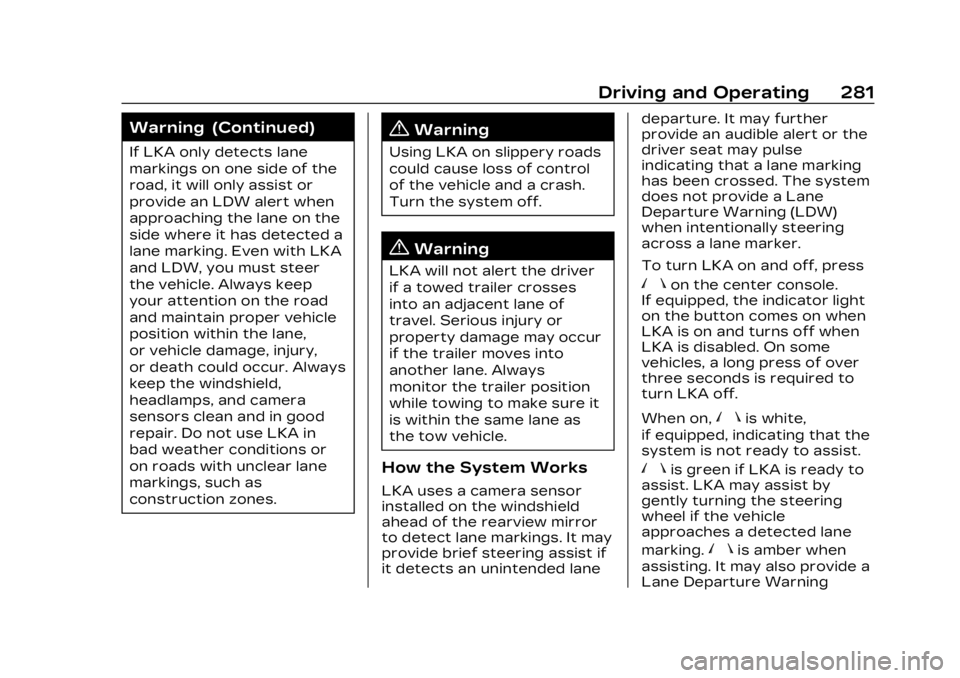
Cadillac Lyriq Owner Manual (GMNA-Localizing-U.S./Canada-15644413) -
2023 - CRC - 2/23/22
Driving and Operating 281
Warning (Continued)
If LKA only detects lane
markings on one side of the
road, it will only assist or
provide an LDW alert when
approaching the lane on the
side where it has detected a
lane marking. Even with LKA
and LDW, you must steer
the vehicle. Always keep
your attention on the road
and maintain proper vehicle
position within the lane,
or vehicle damage, injury,
or death could occur. Always
keep the windshield,
headlamps, and camera
sensors clean and in good
repair. Do not use LKA in
bad weather conditions or
on roads with unclear lane
markings, such as
construction zones.
{Warning
Using LKA on slippery roads
could cause loss of control
of the vehicle and a crash.
Turn the system off.
{Warning
LKA will not alert the driver
if a towed trailer crosses
into an adjacent lane of
travel. Serious injury or
property damage may occur
if the trailer moves into
another lane. Always
monitor the trailer position
while towing to make sure it
is within the same lane as
the tow vehicle.
How the System Works
LKA uses a camera sensor
installed on the windshield
ahead of the rearview mirror
to detect lane markings. It may
provide brief steering assist if
it detects an unintended lanedeparture. It may further
provide an audible alert or the
driver seat may pulse
indicating that a lane marking
has been crossed. The system
does not provide a Lane
Departure Warning (LDW)
when intentionally steering
across a lane marker.
To turn LKA on and off, press
non the center console.
If equipped, the indicator light
on the button comes on when
LKA is on and turns off when
LKA is disabled. On some
vehicles, a long press of over
three seconds is required to
turn LKA off.
When on,
nis white,
if equipped, indicating that the
system is not ready to assist.
nis green if LKA is ready to
assist. LKA may assist by
gently turning the steering
wheel if the vehicle
approaches a detected lane
marking.
nis amber when
assisting. It may also provide a
Lane Departure Warning
Page 296 of 424
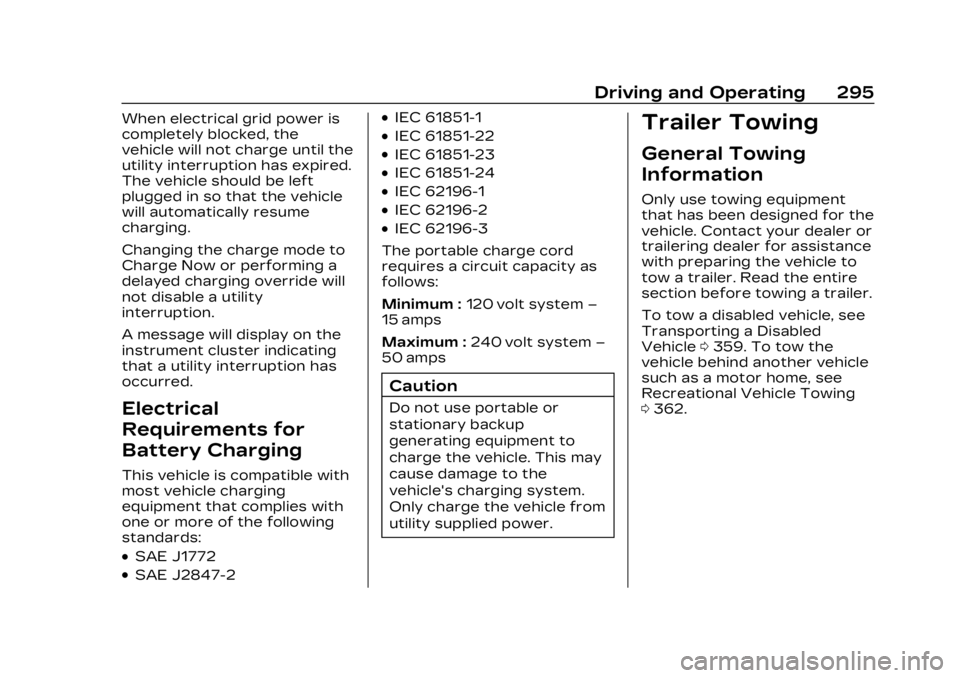
Cadillac Lyriq Owner Manual (GMNA-Localizing-U.S./Canada-15644413) -
2023 - CRC - 2/23/22
Driving and Operating 295
When electrical grid power is
completely blocked, the
vehicle will not charge until the
utility interruption has expired.
The vehicle should be left
plugged in so that the vehicle
will automatically resume
charging.
Changing the charge mode to
Charge Now or performing a
delayed charging override will
not disable a utility
interruption.
A message will display on the
instrument cluster indicating
that a utility interruption has
occurred.
Electrical
Requirements for
Battery Charging
This vehicle is compatible with
most vehicle charging
equipment that complies with
one or more of the following
standards:
.SAE J1772
.SAE J2847-2
.IEC 61851-1
.IEC 61851-22
.IEC 61851-23
.IEC 61851-24
.IEC 62196-1
.IEC 62196-2
.IEC 62196-3
The portable charge cord
requires a circuit capacity as
follows:
Minimum : 120 volt system –
15 amps
Maximum : 240 volt system –
50 amps
Caution
Do not use portable or
stationary backup
generating equipment to
charge the vehicle. This may
cause damage to the
vehicle's charging system.
Only charge the vehicle from
utility supplied power.
Trailer Towing
General Towing
Information
Only use towing equipment
that has been designed for the
vehicle. Contact your dealer or
trailering dealer for assistance
with preparing the vehicle to
tow a trailer. Read the entire
section before towing a trailer.
To tow a disabled vehicle, see
Transporting a Disabled
Vehicle 0359. To tow the
vehicle behind another vehicle
such as a motor home, see
Recreational Vehicle Towing
0 362.
Page 297 of 424

Cadillac Lyriq Owner Manual (GMNA-Localizing-U.S./Canada-15644413) -
2023 - CRC - 2/23/22
296 Driving and Operating
Driving
Characteristics and
Towing Tips
{Warning
You can lose control when
towing a trailer if the correct
equipment is not used or the
vehicle is not driven
properly. For example, if the
trailer is too heavy or the
trailer brakes are
inadequate for the load, the
vehicle may not stop as
expected. You and others
could be seriously injured.
The vehicle may also be
damaged, and the repairs
would not be covered by the
vehicle warranty. Pull a
trailer only if all the steps in
this section have been
followed. Ask your dealer for
advice and information
about towing a trailer with
the vehicle.
Driving with a Trailer
Trailering is different than just
driving the vehicle by itself.
Trailering affects handling,
acceleration, braking, and
durability. Successful and safe
trailering requires proper use
of the correct equipment.
The following information has
many time-tested, important
trailering tips and safety rules.
Many of these are important
for your safety and that of
your passengers. Read this
section carefully before
towing a trailer.
When towing a trailer:
.Become familiar with and
follow all state and local laws
that apply to trailer towing.
These requirements vary
from state to state.
.State laws may require the
use of extended side view
mirrors. Even if not required,
you should install extendedside view mirrors if your
visibility is limited or
restricted while towing.
.Do not tow a trailer during
the first 800 km (500 mi) of
vehicle use to prevent
damage to vehicle.
.During the first 800 km
(500 mi) of trailer towing, do
not drive over 80 km/h
(50 mph) and do not make
starts at full throttle.
.Vehicles can tow in D (Drive).
If equipped, the following
driver assistance features
should be turned off when
towing a trailer:
.Park Assist
.Automatic Parking
Assist (APA)
.Reverse Automatic
Braking (RAB)
If equipped, the following
driver assistance features
should be turned to alert or
off when towing a trailer,
unless equipped with Super
Cruise:
Page 298 of 424

Cadillac Lyriq Owner Manual (GMNA-Localizing-U.S./Canada-15644413) -
2023 - CRC - 2/23/22
Driving and Operating 297
.Automatic Emergency
Braking (AEB)
.Front Pedestrian
Braking (FPB)
If equipped with Lane Change
Alert (LCA), the LCA detection
zones that extend back from
the side of the vehicle do not
move further back when a
trailer is towed. Use caution
while changing lanes when
towing a trailer.
If equipped with Rear Cross
Traffic Alert (RCTA), use
caution while backing up when
towing a trailer, as the RCTA
detection zones that extend
out from the back of the
vehicle do not move further
back when a trailer is towed.
Towing a trailer requires
experience. The combination
of the vehicle and trailer is
longer and not as responsive
as the vehicle itself. Become
familiar with handling and
braking of the combination by
driving on a level road surface
before driving on public roads. The trailer structure, the tires,
and the brakes must be all be
rated to carry the intended
cargo. Inadequate trailer
equipment can cause the
combination to operate in an
unexpected or unsafe manner.
Before driving, inspect all
trailer hitch parts and
attachments, safety chains,
electrical connectors, lamps,
tires, and mirrors. See Towing
Equipment
0303. If the trailer
has electric brakes, start the
combination moving and then
manually apply the trailer
brake controller to check the
trailer brakes work. During the
trip, occasionally check that
the cargo and trailer are
secure and that the lamps and
any trailer brakes are working.
Towing with a Stability
Control System
When towing, the stability
control system might be
heard. The system reacts to
vehicle movement caused by
the trailer, which mainly occurs during cornering. This is
normal when towing heavier
trailers.
Following Distance
Stay at least twice as far
behind the vehicle ahead as
you would when driving
without a trailer to help to
avoid heavy braking and
sudden turns.
Passing
More passing distance is
needed when towing a trailer.
The combination of the vehicle
and trailer will not accelerate
as quickly and is much longer
than the vehicle alone. It is
necessary to go much farther
beyond the passed vehicle
before returning to the lane.
Pass on level roadways. Avoid
passing on hills if possible.
Backing Up
Hold the bottom of the
steering wheel with one hand.
To move the trailer to the left,
move that hand to the left. To
Page 299 of 424
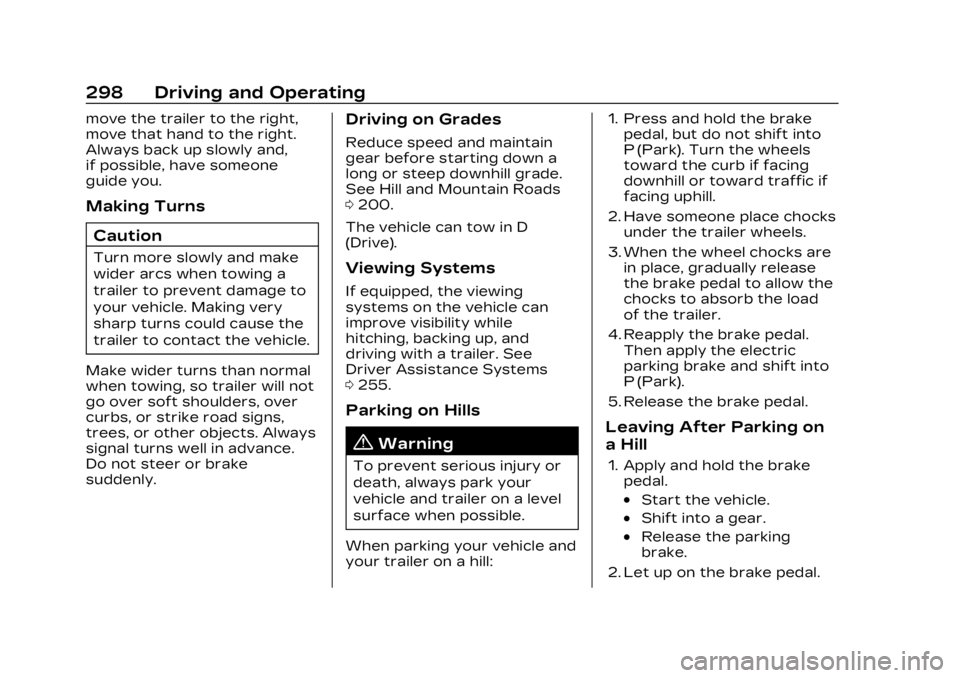
Cadillac Lyriq Owner Manual (GMNA-Localizing-U.S./Canada-15644413) -
2023 - CRC - 2/23/22
298 Driving and Operating
move the trailer to the right,
move that hand to the right.
Always back up slowly and,
if possible, have someone
guide you.
Making TurnsCaution
Turn more slowly and make
wider arcs when towing a
trailer to prevent damage to
your vehicle. Making very
sharp turns could cause the
trailer to contact the vehicle.
Make wider turns than normal
when towing, so trailer will not
go over soft shoulders, over
curbs, or strike road signs,
trees, or other objects. Always
signal turns well in advance.
Do not steer or brake
suddenly.
Driving on Grades
Reduce speed and maintain
gear before starting down a
long or steep downhill grade.
See Hill and Mountain Roads
0 200.
The vehicle can tow in D
(Drive).
Viewing Systems
If equipped, the viewing
systems on the vehicle can
improve visibility while
hitching, backing up, and
driving with a trailer. See
Driver Assistance Systems
0 255.
Parking on Hills
{Warning
To prevent serious injury or
death, always park your
vehicle and trailer on a level
surface when possible.
When parking your vehicle and
your trailer on a hill: 1. Press and hold the brake
pedal, but do not shift into
P (Park). Turn the wheels
toward the curb if facing
downhill or toward traffic if
facing uphill.
2. Have someone place chocks under the trailer wheels.
3. When the wheel chocks are in place, gradually release
the brake pedal to allow the
chocks to absorb the load
of the trailer.
4. Reapply the brake pedal. Then apply the electric
parking brake and shift into
P (Park).
5. Release the brake pedal.
Leaving After Parking on
a Hill
1. Apply and hold the brake pedal.
.Start the vehicle.
.Shift into a gear.
.Release the parking
brake.
2. Let up on the brake pedal.
Page 300 of 424
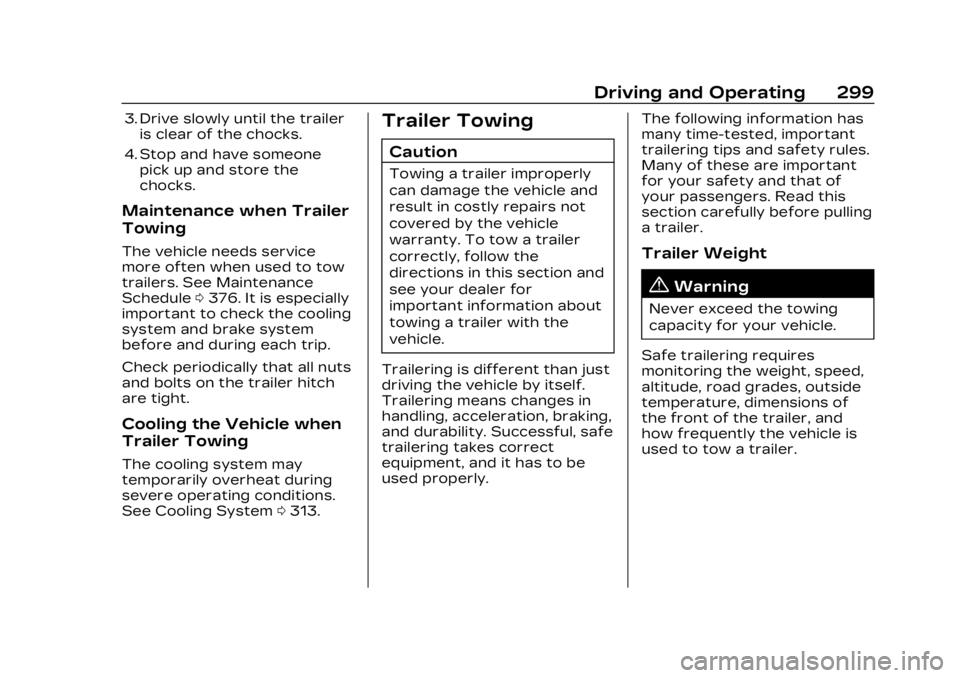
Cadillac Lyriq Owner Manual (GMNA-Localizing-U.S./Canada-15644413) -
2023 - CRC - 2/23/22
Driving and Operating 299
3. Drive slowly until the traileris clear of the chocks.
4. Stop and have someone pick up and store the
chocks.
Maintenance when Trailer
Towing
The vehicle needs service
more often when used to tow
trailers. See Maintenance
Schedule 0376. It is especially
important to check the cooling
system and brake system
before and during each trip.
Check periodically that all nuts
and bolts on the trailer hitch
are tight.
Cooling the Vehicle when
Trailer Towing
The cooling system may
temporarily overheat during
severe operating conditions.
See Cooling System 0313.
Trailer Towing
Caution
Towing a trailer improperly
can damage the vehicle and
result in costly repairs not
covered by the vehicle
warranty. To tow a trailer
correctly, follow the
directions in this section and
see your dealer for
important information about
towing a trailer with the
vehicle.
Trailering is different than just
driving the vehicle by itself.
Trailering means changes in
handling, acceleration, braking,
and durability. Successful, safe
trailering takes correct
equipment, and it has to be
used properly. The following information has
many time-tested, important
trailering tips and safety rules.
Many of these are important
for your safety and that of
your passengers. Read this
section carefully before pulling
a trailer.
Trailer Weight
{Warning
Never exceed the towing
capacity for your vehicle.
Safe trailering requires
monitoring the weight, speed,
altitude, road grades, outside
temperature, dimensions of
the front of the trailer, and
how frequently the vehicle is
used to tow a trailer.
Page 301 of 424
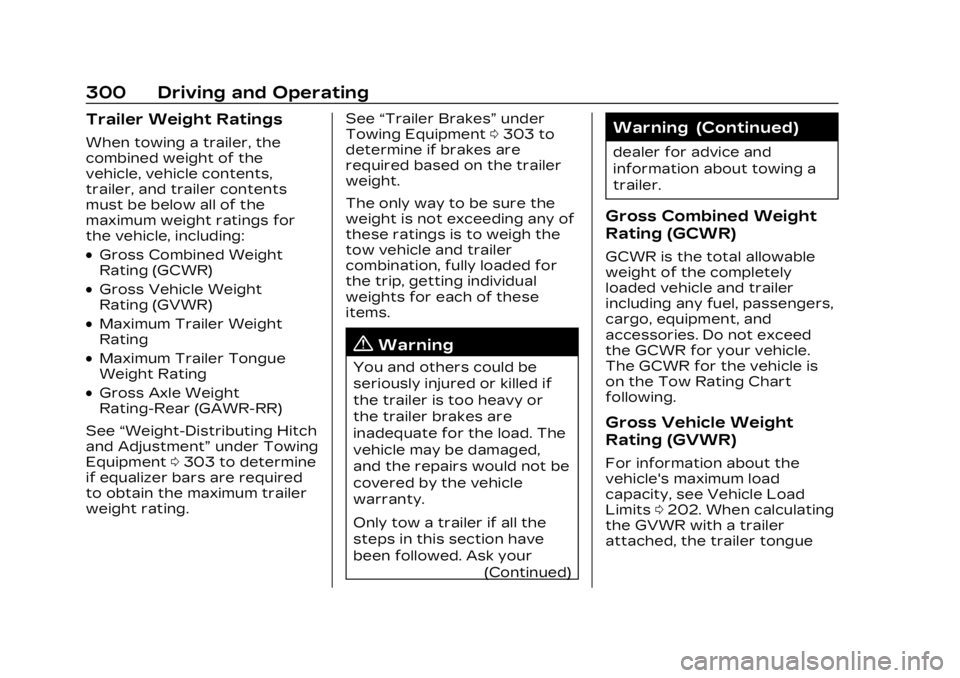
Cadillac Lyriq Owner Manual (GMNA-Localizing-U.S./Canada-15644413) -
2023 - CRC - 2/23/22
300 Driving and Operating
Trailer Weight Ratings
When towing a trailer, the
combined weight of the
vehicle, vehicle contents,
trailer, and trailer contents
must be below all of the
maximum weight ratings for
the vehicle, including:
.Gross Combined Weight
Rating (GCWR)
.Gross Vehicle Weight
Rating (GVWR)
.Maximum Trailer Weight
Rating
.Maximum Trailer Tongue
Weight Rating
.Gross Axle Weight
Rating-Rear (GAWR-RR)
See “Weight-Distributing Hitch
and Adjustment” under Towing
Equipment 0303 to determine
if equalizer bars are required
to obtain the maximum trailer
weight rating. See
“Trailer Brakes” under
Towing Equipment 0303 to
determine if brakes are
required based on the trailer
weight.
The only way to be sure the
weight is not exceeding any of
these ratings is to weigh the
tow vehicle and trailer
combination, fully loaded for
the trip, getting individual
weights for each of these
items.
{Warning
You and others could be
seriously injured or killed if
the trailer is too heavy or
the trailer brakes are
inadequate for the load. The
vehicle may be damaged,
and the repairs would not be
covered by the vehicle
warranty.
Only tow a trailer if all the
steps in this section have
been followed. Ask your
(Continued)
Warning (Continued)
dealer for advice and
information about towing a
trailer.
Gross Combined Weight
Rating (GCWR)
GCWR is the total allowable
weight of the completely
loaded vehicle and trailer
including any fuel, passengers,
cargo, equipment, and
accessories. Do not exceed
the GCWR for your vehicle.
The GCWR for the vehicle is
on the Tow Rating Chart
following.
Gross Vehicle Weight
Rating (GVWR)
For information about the
vehicle's maximum load
capacity, see Vehicle Load
Limits0202. When calculating
the GVWR with a trailer
attached, the trailer tongue
Page 302 of 424

Cadillac Lyriq Owner Manual (GMNA-Localizing-U.S./Canada-15644413) -
2023 - CRC - 2/23/22
Driving and Operating 301
weight must be included as
part of the weight the vehicle
is carrying.
Maximum Trailer Weight
The maximum trailer weight
rating is calculated assuming
the tow vehicle has a driver, a
front seat passenger, and all
required trailering equipment.
This value represents the
heaviest trailer the vehicle can
tow, but it may be necessary
to reduce the trailer weight to
stay within the GCW, GVWR,
maximum trailer tongue load,
or GAWR-RR for the vehicle.
Use the tow rating chart to
determine how much the
trailer can weigh, based on the
vehicle model and options.Vehicle
Maximum Trailer
Weight with
Trailer Brakes† GCWR*
LYRIQ RWD/AWD 1580 kg (3,500 lb) 4435 kg (9,777 lb)
† For trailers without trailer brakes the maximum trailer weight
is 1580 kg (3,500 lb). See Towing Equipment 0303.
* The Gross Combination Weight Rating (GCWR) is the total
allowable weight of the completely loaded vehicle and trailer
including any passengers, cargo, equipment, and conversions.
Do not exceed the GCWR for the vehicle.
Maximum Trailer Tongue
Weight
The Maximum Trailer Tongue
Weight Rating is the allowable
trailer tongue weight that the
vehicle can support using a
conventional trailer hitch.
It may be necessary to reduce
the overall trailer weight to
stay within the maximum
trailer tongue weight rating
while still maintaining the
correct trailer load balance.
Do not exceed a maximum
trailer tongue weight of 159 kg
(350 lb).